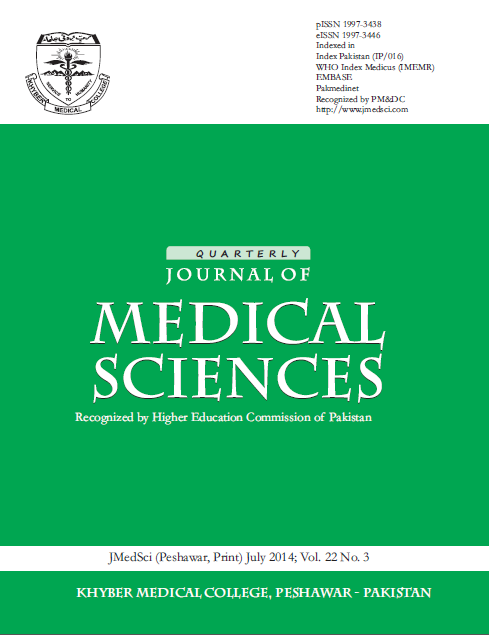INTRANASAL SPLINTS AND NASAL SEPTAL SURGERY
Keywords:
Septal deviation, nasal obstruction, Septoplasty, Septal SplintsAbstract
Objectives: To compare the efficacy of transseptal suturing technique with conventional nasal splints in the classic septoplasty incision.
Material and Methods: This was a comparative study done in the department of ENT and Head and Neck Surgery Department of Khyber Teaching Hospital, Peshawar Pakistan, from January 2013 to June 2014. A total of 150 patients were included in this study. These patients were divided into two groups, Group A includes those patients in which no nasal splints were kept after nasal septal surgery and Group B includes patients in whome nasal septal splints were kept in. After taking proper history and performing clinical examination these patients were divided into two groups by convenience sampling technique. This data was recorded on preformed proforma. All the patients were followed up at 3rd, 10th and 30th day of postoperative period. The record of nasal adhesions and septal perforation was noticed and compared between two groups.
Results: Group A which comprised of Septal surgery without splints showed better results in the terms of postoperative
septal perforations and intranasal adhesions as compared to Group B with intranasal splints after septal surgery.
Conclusion: The procedure of Nasal Septal surgery without splints was better in reducing postoperative complications although it was more time consuming.
Downloads
Published
How to Cite
Issue
Section
License
All articles published in the Journal of Medical Sciences (JMS) are licensed under the Creative Commons Attribution 4.0 International License (CC-BY 4.0). Under the CC BY 4.0 license, author(s) retain the ownership of the copyright publishing rights without restrictions for their content, and allow others to copy, use, print, share, modify, and distribute the content of the article even for commercial purposes as long as the original authors and the journal are properly cited. No permission is required from the author/s or the publishers for this purpose. Appropriate attribution can be provided by simply citing the original article. The corresponding author has the right to grant on behalf of all authors, a worldwide license to JMS and its licensees in all forms, formats, and media (whether known now or created in the future), The corresponding author must certify and warrant the authorship and proprietorship and should declare that he/she has not granted or assigned any of the article’s rights to any other person or body.
The corresponding author must compensate the journal for any costs, expenses, or damages that the JMS may incur as a result of any breach of these warranties including any intentional or unintentional errors, omissions, copyright issues, or plagiarism. The editorial office must be notified upon submission if an article contains materials like text, pictures, tables, or graphs from other copyrighted sources. The JMS reserves the right to remove any images, figures, tables, or other content, from any article, whether before or after publication, if concerns are raised about copyright, license, or permissions and the authors are unable to provide documentation confirming that appropriate permissions were obtained for publication of the content in question.




